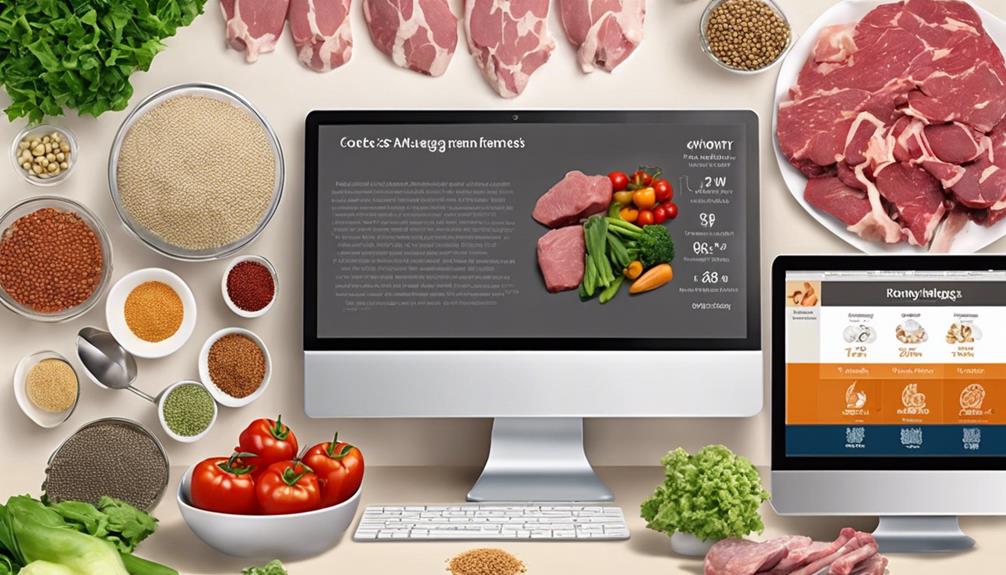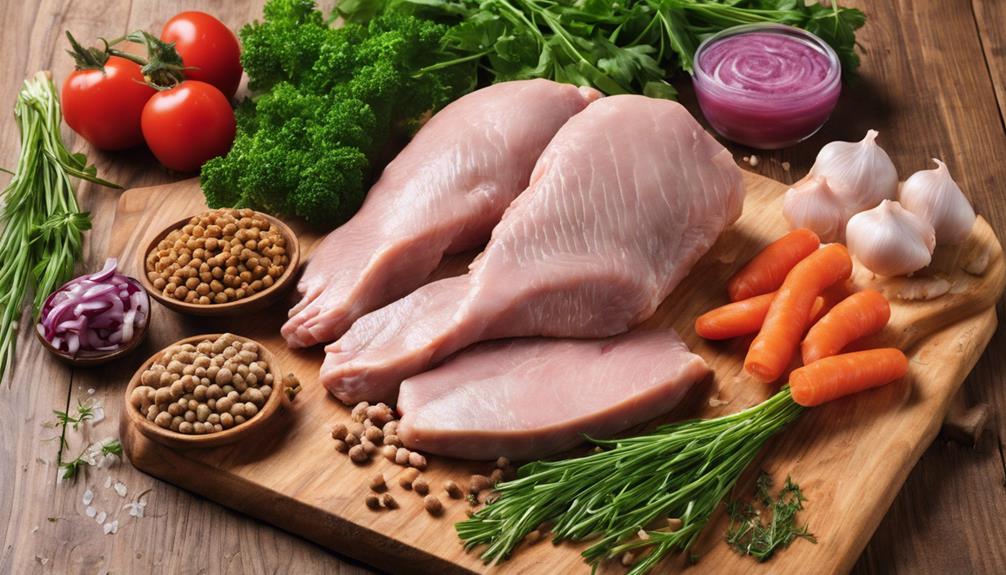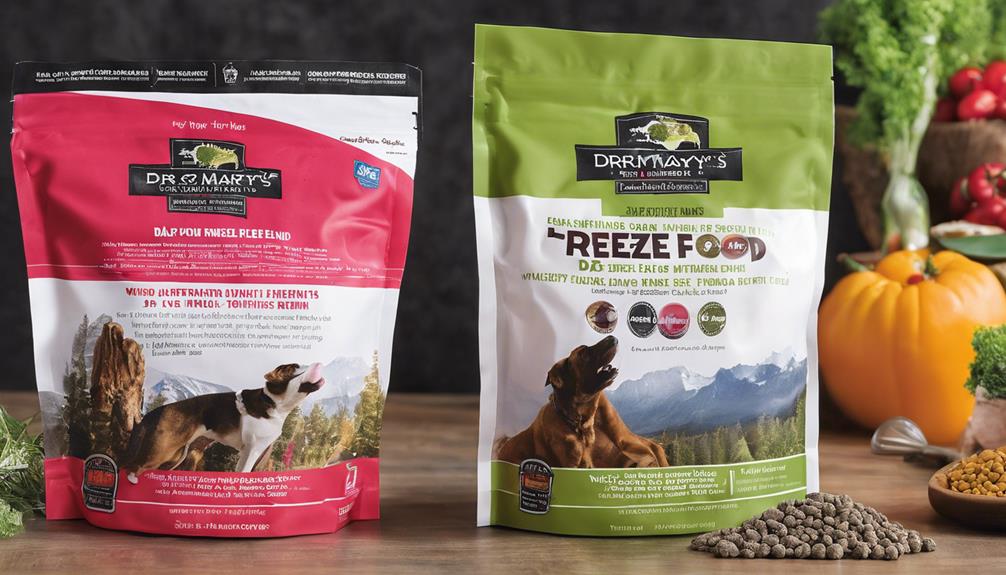Creating your own raw dog food recipes as a beginner has numerous advantages for your pet. Homemade meals allow for tailored nutrition, ensuring high quality and adaptability. Concentrating on essential nutrients such as proteins, fats, vitamins, and minerals, well-balanced meals support overall health. Beginner-friendly recipes feature lean proteins like chicken and turkey, as well as offal and omega-3 rich ingredients for a well-rounded diet. Seeking guidance from experts and slowly introducing ingredients ensures a seamless transition. Explore the realm of raw feeding for further information on enhancing your dog’s nutrition.
Key Takeaways
- Start with simple ingredients like ground beef, organs, bones, and vegetables.
- Adjust recipes for specific needs by varying calorie content and ingredients.
- Lean proteins like chicken, turkey, and rabbit support muscle development.
- Incorporate omega-3 rich foods like salmon for skin and coat health.
- Gradually introduce new ingredients to monitor allergies and ensure a balanced diet.
Benefits of Raw Dog Food
Raw dog food offers numerous benefits that cater to your pet's specific dietary requirements and health needs. When considering a raw diet for your furry friend, homemade recipes provide the flexibility to tailor meals to their individual needs. By preparing meals at home, you can guarantee the nutritional value of each ingredient, promoting peak health for your dog. This personalized approach allows for quick adjustments to accommodate different life stages, ensuring that your pet receives the necessary nutrients at every age.
Creating homemade raw dog food also gives you control over ingredient sources, reducing the risks associated with potential recalls in commercial pet foods. Additionally, better budgeting and bulk buying options make homemade raw dog food a cost-effective and quality nutritional choice for your pet.
The health benefits of a raw diet include improved digestion, healthier skin and coat, better dental health, and reduced allergy symptoms, all contributing to your pet's overall well-being.
Essential Nutrients for Dogs

After exploring the benefits of raw dog food, understanding the essential nutrients for dogs becomes paramount in guaranteeing your pet's peak health and wellbeing.
- Proteins: These are essential for muscle development and repair. Sources like meat, organs, and eggs provide necessary amino acids crucial for overall health.
- Fats: Essential for skin and coat health, energy, and nutrient absorption. They play a vital role in your dog's well-being.
- Carbohydrates: While not as critical as proteins and fats, they can still provide energy and fiber for digestive health.
- Vitamins and Minerals: Essential for various physiological processes like bone health, immune function, and muscle contractions. Make sure your homemade dog food recipes are rich in these nutrients for a balanced diet.
Importance of Balanced Meals
Ensuring that your dog's meals are vital for providing all the necessary nutrients for their prime health and well-being is essential.
A balanced diet consisting of raw dog food is essential to support your furry friend's overall health. By incorporating a variety of whole foods in their meals, you can enhance the nutritional value and make sure they receive a wide range of essential nutrients.
Following guidelines from organizations like AAFCO or FEDIAF can help you create well-rounded meals that meet your dog's nutritional requirements. Proper proportions of nutrients in their diet are key to maintaining prime health and well-being.
Utilizing nutrient analysis software can assist you in formulating recipes that provide the right balance of proteins, fats, vitamins, and minerals. Remember, a balanced diet is the cornerstone of your dog's health, so prioritize whole foods and nutrient-rich ingredients in their raw meals for a happy and healthy canine companion.
Beginner-Friendly Raw Recipes

When developing raw dog food recipes suitable for beginners, it's important to concentrate on straightforward ingredients and simple preparation methods. These recipes usually consist of a well-rounded combination of muscle meat, organs, bones, and some vegetables/fruits.
Beginning with fundamental recipes such as ground beef with organs and vegetables can guarantee a balanced meal for your beloved pet.
Ingredient Selection Tips
To guarantee high-quality nutrition in raw dog food recipes, I recommend starting with lean meats containing 10-20% fat. Here are some tips for selecting ingredients:
- Choose Quality Sources: Opt for ingredients from local farmers or supermarkets for freshness.
- Prioritize High-Quality: Select free-range, grass-fed, and organic meats for superior nutrition.
- Build Relationships: Establish connections with suppliers to ensure consistent ingredient quality.
- Plan and Experiment: Create a shopping list to streamline the process and try out various recipes for your dog's health benefits.
Meal Preparation Basics
Starting with the basics of meal preparation in raw dog food recipes, beginners can easily create nutritious meals for their furry companions by following simple steps. When making homemade raw dog food, it's important to maintain the right balance of meat, bones, organs, and vegetables/fruits, typically in a 7:1:1:1 ratio.
Make sure that the bone content falls within 10-15% to provide essential calcium for your dog's diet. Ingredients like fresh organic meats, organ mix, and blitzed vegetables are commonly used in raw dog food recipes. The meal preparation basics involve mixing the ingredients, portioning the food, storing it in containers, and freezing it for preservation.
Tailoring specific recipes to cater to different needs, such as Active/Puppy, Working Dog, and Overweight Dog, involves adjusting calorie content and ingredients accordingly.
Nutrient Analysis Software

Utilizing the Animal Diet Formulator software streamlines recipe formulation and provides thorough macro and micro nutrient analysis for precise nutritional evaluation.
- Easy Formulation: The software simplifies the process of creating balanced raw food diet recipes for dogs.
- Accurate Analysis: It guarantees that the recipes meet the necessary dog nutrition standards for complete and balanced meals.
- Detailed Breakdown: The software offers a detailed breakdown of macro and micro nutrients, aiding in creating ideal diets.
- Tailored Nutrition: It allows for customization based on individual dog requirements, supporting their health and activity levels.
Lean Protein Sources

When preparing raw dog food, it's important to focus on lean protein sources like:
- Chicken
- Turkey
- Rabbit
- Lean cuts of beef
These options are rich in essential amino acids necessary for muscle development and overall canine health.
Incorporating a variety of lean proteins in your dog's diet guarantees a balanced nutritional intake.
Meat Options
Lean protein sources like chicken, turkey, rabbit, venison, and lean cuts of beef are essential components in raw dog food recipes. When choosing meat options for your furry friend, it's important to prioritize lean proteins to support their muscle development and overall well-being. Here are some key points to keep in mind:
- Chicken: A versatile and lean protein that dogs usually enjoy.
- Turkey: Another lean option that provides essential amino acids.
- Rabbit: A novel protein that can be beneficial for dogs with food sensitivities.
- Venison: A lean and nutritious choice that adds variety to your dog's diet.
Incorporating a mix of these raw meats ensures your dog receives a well-rounded nutritional profile for best health.
Fish Choices
As we delve into fish choices as lean protein sources for raw dog food recipes, it's crucial to ponder the nutritional benefits they offer and how they can enhance your dog's diet. Fish like sardines and mackerel are excellent options, providing omega-3 fatty acids that contribute to a balanced fat intake for your furry friend. Including fish in homemade dog food adds variety and different nutritional benefits to their meals. These options can be particularly beneficial for dogs with allergies or sensitivities to other meats. Remember, selecting fresh, high-quality fish is key to ensuring your dog receives optimal nutrient content. Consider adding these fish choices to your raw dog food recipes for a healthy and well-rounded diet.
| Fish Choices | Nutritional Benefits | Key Features |
|---|---|---|
| Sardines | High in Omega-3 Fatty Acids | Small, oily fish rich in essential nutrients |
| Mackerel | Source of Lean Protein | Contains Omega-3s and vitamins D and B12 |
| Salmon | Omega-3 Fatty Acids | Rich in protein and beneficial for skin and coat health |
Incorporating Offal in Recipes

Incorporating offal in raw dog food recipes guarantees a nutrient-rich diet for your furry companion. Organ meats such as liver, kidney, heart, and spleen are packed with essential nutrients important for your dog's health. Here's why offal is a must-have in your dog's raw diet:
- Rich in Essential Nutrients: Offal provides vitamins A, D, E, and K, along with minerals like iron and zinc, ensuring your dog gets a well-rounded nutritional intake.
- Liver Powerhouse: Liver, a type of offal, is especially beneficial, containing high levels of vitamin A and B vitamins important for your dog's overall well-being.
- Balanced Inclusion: Offal should constitute about 10% of your dog's raw diet, balancing it with muscle meat, bones, and other ingredients to create a complete and balanced meal.
- Nutritional Diversity: Including offal in recipes ensures your dog receives a wide array of essential nutrients, promoting the best health and vitality.
Omega-3 Rich Ingredients

Ensuring your dog's peak health and well-being involves incorporating omega-3 rich ingredients into their raw diet. Omega-3 fatty acids play an important role in supporting various aspects of your furry friend's health, such as brain function, joint health, and maintaining a shiny coat. Fish, including salmon, mackerel, and sardines, are fantastic sources of these essential fatty acids. Consider adding canned sardines in spring water to your dog's meals for a natural omega-3 boost. If you prefer plant-based options, flaxseeds, chia seeds, and walnuts are excellent choices rich in omega-3 fatty acids that can benefit your canine companion.
A balanced ratio of omega-3 to omega-6 fatty acids is essential for reducing inflammation and supporting immune function in dogs. By incorporating omega-3 rich ingredients like fish or plant-based sources such as flaxseeds into your dog's raw diet, you're taking a proactive step towards promoting their overall health and well-being.
Consulting Professionals

For the best guidance on raw dog food recipes, consider seeking advice from professionals such as veterinarians or pet nutritionists. When it comes to your furry friend's health and nutrition, consulting experts in canine nutrition is essential. Here are some reasons why seeking professional advice is beneficial:
- Tailored Diet Plans: Professionals like Dr. Conor Brady offer personalized online consultations focusing on raw feeding. These consultations can provide customized diet plans tailored to your dog's specific needs.
- Expert Insights: Access valuable information on canine nutrition from experts like Dr. Brady, who's a vast readership and expertise in raw feeding. Their insights can help you make informed decisions regarding your dog's diet.
- Comprehensive Online Courses: Consider enrolling in online courses by experts like Dr. Brady to deepen your understanding of dog behavior, dietary requirements, and raw feeding practices.
- Health Guidance: Professionals can offer guidance on health issues, new puppy care, and teeth cleaning services related to raw dog food recipes, ensuring your pet's well-being. Consulting with these experts can help you navigate the world of raw feeding with confidence.
Gradual Ingredient Introduction

When switching to a raw dog food diet, it's important to introduce new ingredients gradually to monitor any potential allergies or sensitivities.
Start by adding small amounts of one new ingredient at a time to pinpoint any adverse reactions your dog may have.
Remember to allow a few days between each new ingredient introduction to accurately observe your dog's response.
Ingredient Transition Tips
To smoothly shift your dog to a raw food diet, gradually introducing new ingredients into their meals is important. When changing your dog's diet, follow these steps:
- Begin by adding small amounts of new ingredients, such as proteins or vegetables, to your dog's current meals.
- Monitor your dog for any signs of allergies or sensitivities to the new recipes, like changes in body weight or digestive issues.
- Slowly increase the quantity of the new ingredients while decreasing the old ones to balance the shift effectively.
- This gradual approach helps your dog adjust to the new diet, ensuring a smooth switch to raw feeding without causing any digestive upset or health issues.
Safety Precautions for Transition
As we progress towards incorporating new ingredients into your dog's meals, it's important to think about safety precautions for a smooth and gradual shift.
When shifting to a pre-made raw diet, remember to introduce new elements slowly over a period of 7-10 days. Start with a small amount of the new ingredient and gradually increase it to allow your dog's digestive system to adjust. Keep a close eye on your furry friend for any signs of allergies or intolerance during this process. If you notice any adverse reactions, consult with a veterinarian for guidance.
Monitoring for allergies is vital to make sure that the adjustment is successful and that your dog thrives on their new raw diet.
Frequently Asked Questions
How Do I Make Raw Food for My Dog at Home?
I create raw food for my dog at home by meticulously balancing muscle meat, bones, organs, and veggies/fruits. I guarantee the correct calcium levels for bone health. Mixing, portioning, and freezing the food in tupperware help maintain its freshness and nutrition.
What Is the Best Mix for Raw Dog Food?
I find that a balanced mix of 70% muscle meat with fat, 10% raw edible bones, 10% organs, 5% fresh fruits/veggies, and 5% dairy/supplements/nuts/seeds creates ideal nutrition. It's essential for my dog's health and well-being.
How Do I Start My Dog on Raw Diet?
To start my dog on a raw diet, I gradually introduce small amounts of raw food mixed with their current diet to avoid digestive issues. I monitor their health, consult a professional, and track their progress for best results.
What Should a Dog's Raw Diet Consist Of?
A dog's raw diet should consist of 70% muscle meat with fat, 10% raw edible bones, 10% organs, 5% fresh vegetables/fruits, and 5% dairy/supplements/nuts/seeds. It's important to provide a balanced mix for best health.
What are some beginner-friendly raw dog food recipes suitable for Labradors?
If you’re looking for easy raw dog food recipes for your Labrador, consider starting with a simple recipe like a raw meat patty mixed with chopped vegetables and a bit of fruit. As your dog gets used to the raw diet, you can gradually introduce more variety into their meals.
Conclusion
To sum up, raw dog food recipes can offer numerous benefits for your furry friend's health and well-being. By integrating essential nutrients, balanced meals, and omega-3 rich ingredients, you can guarantee a nutritious diet for your pet.
Seeking advice from professionals and utilizing nutrient analysis software can help you create ideal meal plans. Remember, gradual introduction of new ingredients is crucial to a successful shift.
Just like a well-balanced meal, a carefully planned raw diet can be the key to a happy and healthy pup.










